Facies Classification
Papers and Code
Facies Classification with Copula Entropy
Jan 24, 2025In this paper we propose to apply copula entropy (CE) to facies classification. In our method, the correlations between geological variables and facies classes are measured with CE and then the variables associated with large negative CEs are selected for classification. We verified the proposed method on a typical facies dataset for facies classification and the experimental results show that the proposed method can select less geological variables for facies classification without sacrificing classification performance. The geological variables such selected are also interpretable to geologists with geological meanings due to the rigorous definition of CE.
Comparative Analysis of Pre-trained Deep Learning Models and DINOv2 for Cushing's Syndrome Diagnosis in Facial Analysis
Jan 21, 2025



Cushing's syndrome is a condition caused by excessive glucocorticoid secretion from the adrenal cortex, often manifesting with moon facies and plethora, making facial data crucial for diagnosis. Previous studies have used pre-trained convolutional neural networks (CNNs) for diagnosing Cushing's syndrome using frontal facial images. However, CNNs are better at capturing local features, while Cushing's syndrome often presents with global facial features. Transformer-based models like ViT and SWIN, which utilize self-attention mechanisms, can better capture long-range dependencies and global features. Recently, DINOv2, a foundation model based on visual Transformers, has gained interest. This study compares the performance of various pre-trained models, including CNNs, Transformer-based models, and DINOv2, in diagnosing Cushing's syndrome. We also analyze gender bias and the impact of freezing mechanisms on DINOv2. Our results show that Transformer-based models and DINOv2 outperformed CNNs, with ViT achieving the highest F1 score of 85.74%. Both the pre-trained model and DINOv2 had higher accuracy for female samples. DINOv2 also showed improved performance when freezing parameters. In conclusion, Transformer-based models and DINOv2 are effective for Cushing's syndrome classification.
Contrastive Learning Approach for Semi-Supervised Seismic Facies Identification Using High-Confidence Representations
Oct 12, 2022


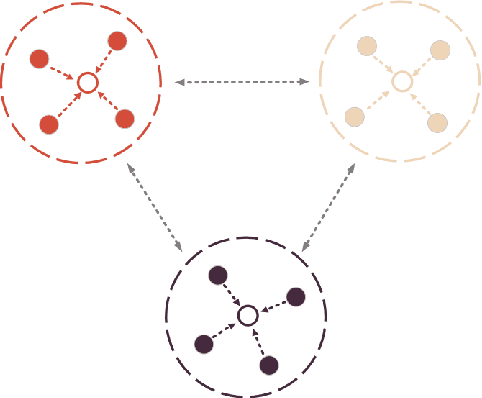
The manual seismic facies annotation relies heavily on the experience of seismic interpreters, and the distribution of seismic facies in adjacent locations is very similar, which means that much of the labeling is costly repetitive work. However, we found that training the model with only a few evenly sampled labeled slices still suffers from severe classification confusion, that is, misidentifying one class of seismic facies as another. To address this issue, we propose a semi-supervised seismic facies identification method using features from unlabeled data for contrastive learning. We sample features in regions with high identification confidence, and use an pixel-level instance discrimination task to narrow the intra-class distance and increase the inter-class distance. Instance discrimination encourages the latent space to produce more distinguishable decision boundaries and reduces the bias in the features of the same class. Our method only needs to extend one branch to compute the contrastive loss without extensive changes to the network structure. We have conducted experiments on two public seismic surveys, SEAM AI and Netherlands F3, and the proposed model achieves an IOU score of more than 90 using only 1% of the annotations in the F3 survey.
Support-vector-machine with Bayesian optimization for lithofacies classification using elastic properties
Mar 14, 2022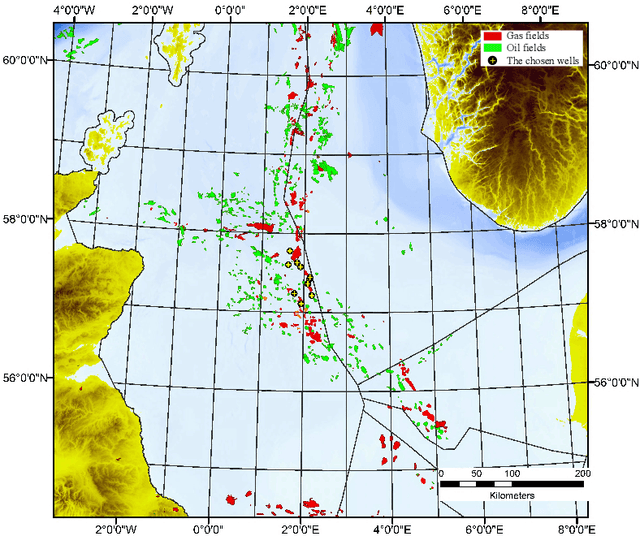
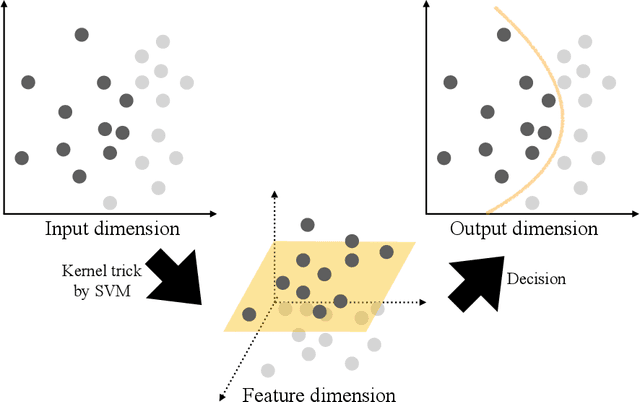
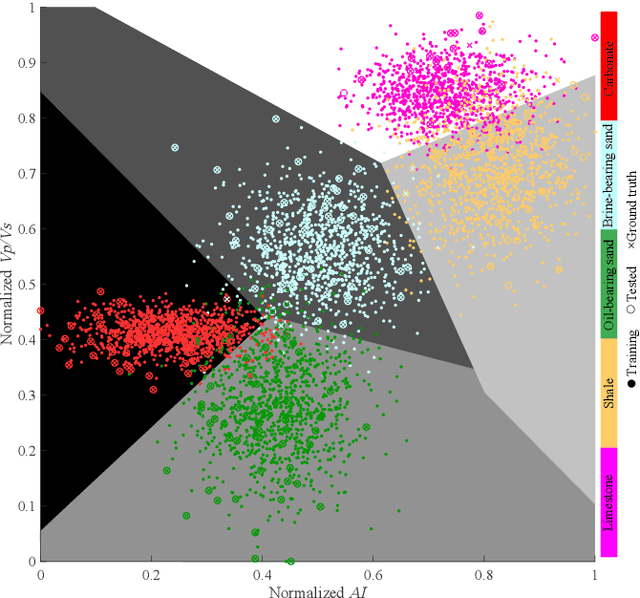
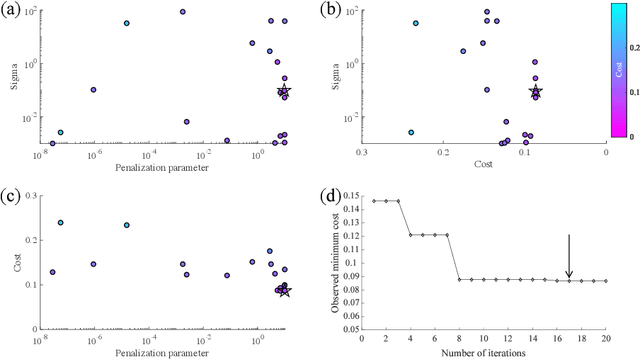
We investigate an applicability of Bayesian-optimization (BO) to optimize hyperparameters associated with support-vector-machine (SVM) in order to classify facies using elastic properties derived from well data in the East Central Graben, UKCS. The cross-plot products of the field dataset appear to be successfully classified with non-linear boundaries. Although there are a few factors to be predetermined in the BO scheme such as an iteration number to deal with a trade-off between the prediction accuracy and the computational cost, this approach effectively reduces possible human subjectivity connected to the architecture of the SVM. Our proposed workflow might be beneficial in resource-exploration and development in terms of subsurface objective technical evaluations.
Unsupervised seismic facies classification using deep convolutional autoencoder
Aug 05, 2020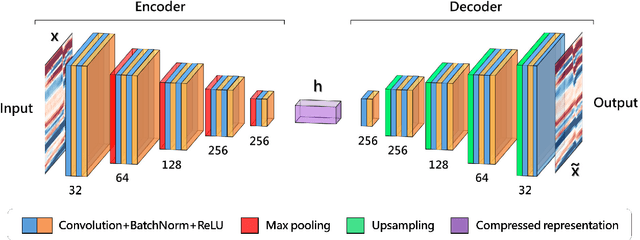


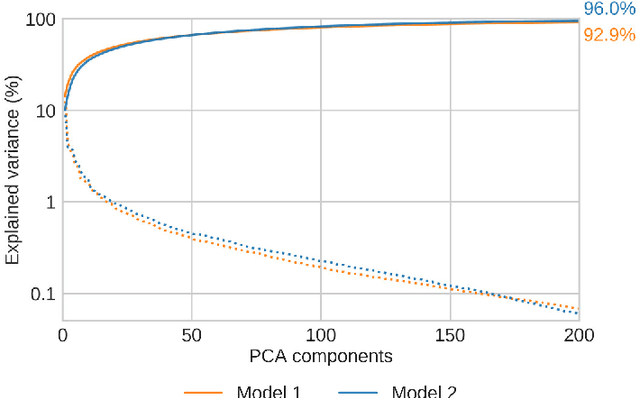
With the increased size and complexity of seismic surveys, manual labeling of seismic facies has become a significant challenge. Application of automatic methods for seismic facies interpretation could significantly reduce the manual labor and subjectivity of a particular interpreter present in conventional methods. A recently emerged group of methods is based on deep neural networks. These approaches are data-driven and require large labeled datasets for network training. We apply a deep convolutional autoencoder for unsupervised seismic facies classification, which does not require manually labeled examples. The facies maps are generated by clustering the deep-feature vectors obtained from the input data. Our method yields accurate results on real data and provides them instantaneously. The proposed approach opens up possibilities to analyze geological patterns in real time without human intervention.
A Machine Learning Benchmark for Facies Classification
Jan 12, 2019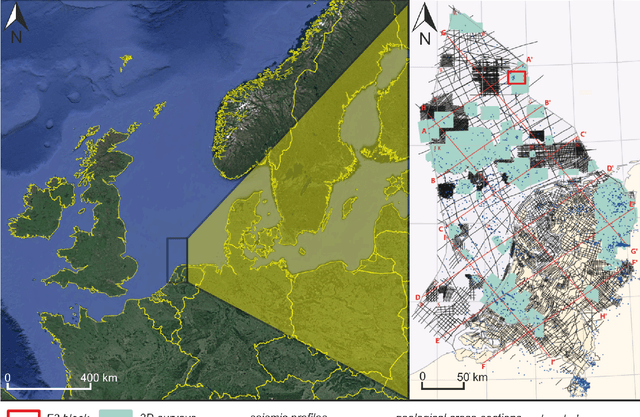

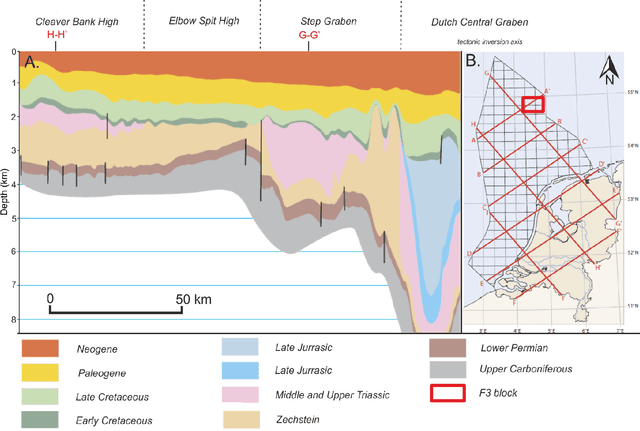

The recent interest in using deep learning for seismic interpretation tasks, such as facies classification, has been facing a significant obstacle, namely the absence of large publicly available annotated datasets for training and testing models. As a result, researchers have often resorted to annotating their own training and testing data. However, different researchers may annotate different classes, or use different train and test splits. In addition, it is common for papers that apply deep learning for facies classification to not contain quantitative results, and rather rely solely on visual inspection of the results. All of these practices have lead to subjective results and have greatly hindered the ability to compare different machine learning models against each other and understand the advantages and disadvantages of each approach. To address these issues, we open-source an accurate 3D geological model of the Netherlands F3 Block. This geological model is based on both well log data and 3D seismic data and is grounded on the careful study of the geology of the region. Furthermore, we propose two baseline models for facies classification based on deconvolution networks and make their codes publicly available. Finally, we propose a scheme for evaluating different models on this dataset, and we share the results of our baseline models. In addition to making the dataset and the code publicly available, this work can help advance research in this area and create an objective benchmark for comparing the results of different machine learning approaches for facies classification for researchers to use in the future.
Seismic Facies Analysis: A Deep Domain Adaptation Approach
Nov 20, 2020


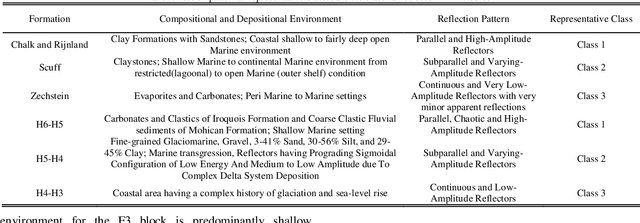
Deep neural networks (DNNs) can learn accurately from large quantities of labeled input data, but DNNs sometimes fail to generalize to test data sampled from different input distributions. Unsupervised Deep Domain Adaptation (DDA) proves useful when no input labels are available, and distribution shifts are observed in the target domain (TD). Experiments are performed on seismic images of the F3 block 3D dataset from offshore Netherlands (source domain; SD) and Penobscot 3D survey data from Canada (target domain; TD). Three geological classes from SD and TD that have similar reflection patterns are considered. In the present study, an improved deep neural network architecture named EarthAdaptNet (EAN) is proposed to semantically segment the seismic images. We specifically use a transposed residual unit to replace the traditional dilated convolution in the decoder block. The EAN achieved a pixel-level accuracy >84% and an accuracy of ~70% for the minority classes, showing improved performance compared to existing architectures. In addition, we introduced the CORAL (Correlation Alignment) method to the EAN to create an unsupervised deep domain adaptation network (EAN-DDA) for the classification of seismic reflections fromF3 and Penobscot. Maximum class accuracy achieved was ~99% for class 2 of Penobscot with >50% overall accuracy. Taken together, EAN-DDA has the potential to classify target domain seismic facies classes with high accuracy.
Application of Machine Learning in Rock Facies Classification with Physics-Motivated Feature Augmentation
Aug 29, 2018

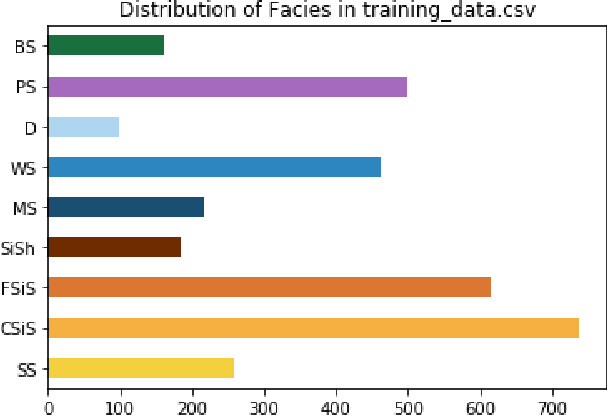

With recent progress in algorithms and the availability of massive amounts of computation power, application of machine learning techniques is becoming a hot topic in the oil and gas industry. One of the most promising aspects to apply machine learning to the upstream field is the rock facies classification in reservoir characterization, which is crucial in determining the net pay thickness of reservoirs, thus a definitive factor in drilling decision making process. For complex machine learning tasks like facies classification, feature engineering is often critical. This paper shows the inclusion of physics-motivated feature interaction in feature augmentation can further improve the capability of machine learning in rock facies classification. We demonstrate this approach with the SEG 2016 machine learning contest dataset and the top winning algorithms. The improvement is roboust and can be $\sim5\%$ better than current existing best F-1 score, where F-1 is an evaluation metric used to quantify average prediction accuracy.
3D CNN-PCA: A Deep-Learning-Based Parameterization for Complex Geomodels
Jul 16, 2020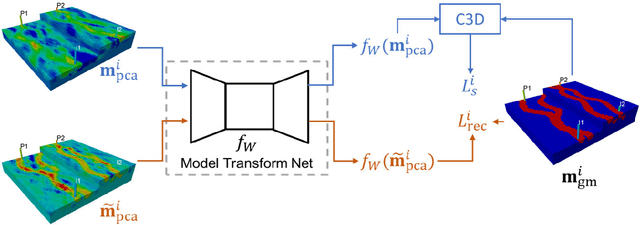



Geological parameterization enables the representation of geomodels in terms of a relatively small set of variables. Parameterization is therefore very useful in the context of data assimilation and uncertainty quantification. In this study, a deep-learning-based geological parameterization algorithm, CNN-PCA, is developed for complex 3D geomodels. CNN-PCA entails the use of convolutional neural networks as a post-processor for the low-dimensional principal component analysis representation of a geomodel. The 3D treatments presented here differ somewhat from those used in the 2D CNN-PCA procedure. Specifically, we introduce a new supervised-learning-based reconstruction loss, which is used in combination with style loss and hard data loss. The style loss uses features extracted from a 3D CNN pretrained for video classification. The 3D CNN-PCA algorithm is applied for the generation of conditional 3D realizations, defined on $60\times60\times40$ grids, for three geological scenarios (binary and bimodal channelized systems, and a three-facies channel-levee-mud system). CNN-PCA realizations are shown to exhibit geological features that are visually consistent with reference models generated using object-based methods. Statistics of flow responses ($\text{P}_{10}$, $\text{P}_{50}$, $\text{P}_{90}$ percentile results) for test sets of 3D CNN-PCA models are shown to be in consistent agreement with those from reference geomodels. Lastly, CNN-PCA is successfully applied for history matching with ESMDA for the bimodal channelized system.
Facies classification from well logs using an inception convolutional network
Jun 02, 2017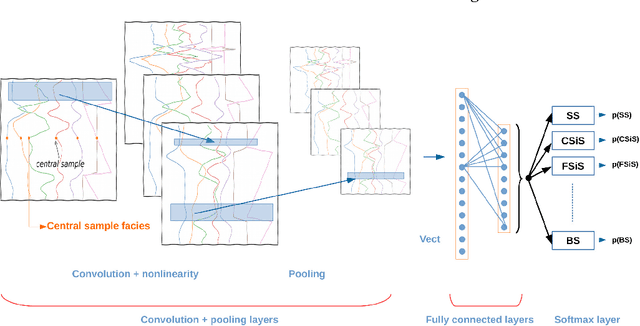



The idea to use automated algorithms to determine geological facies from well logs is not new (see e.g Busch et al. (1987); Rabaute (1998)) but the recent and dramatic increase in research in the field of machine learning makes it a good time to revisit the topic. Following an exercise proposed by Dubois et al. (2007) and Hall (2016) we employ a modern type of deep convolutional network, called \textit{inception network} (Szegedy et al., 2015), to tackle the supervised classification task and we discuss the methodological limits of such problem as well as further research opportunities.
 Add to Chrome
Add to Chrome Add to Firefox
Add to Firefox Add to Edge
Add to Edge